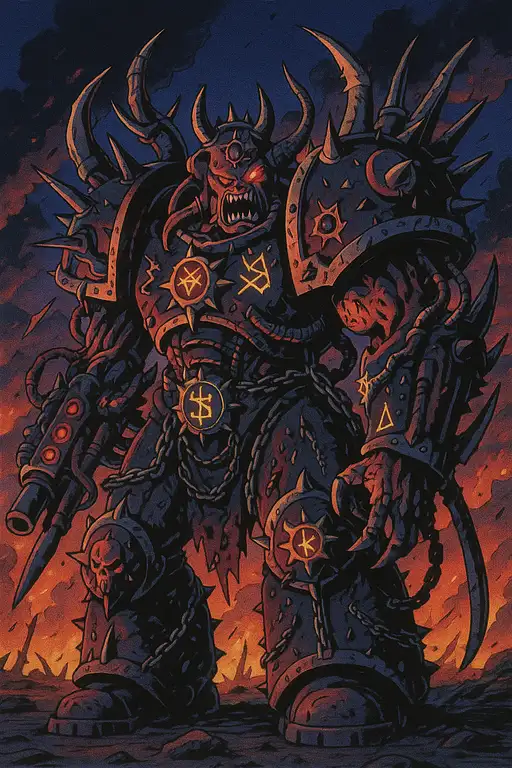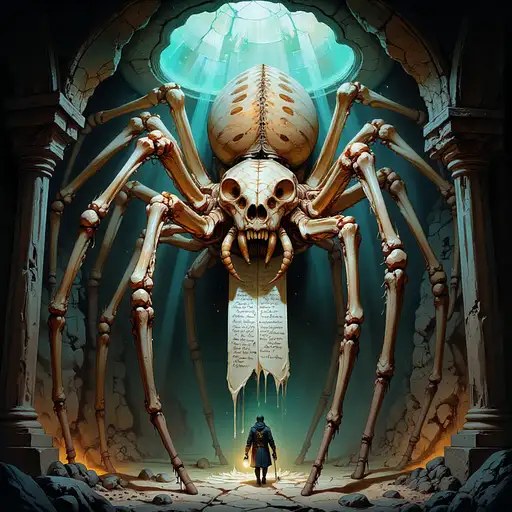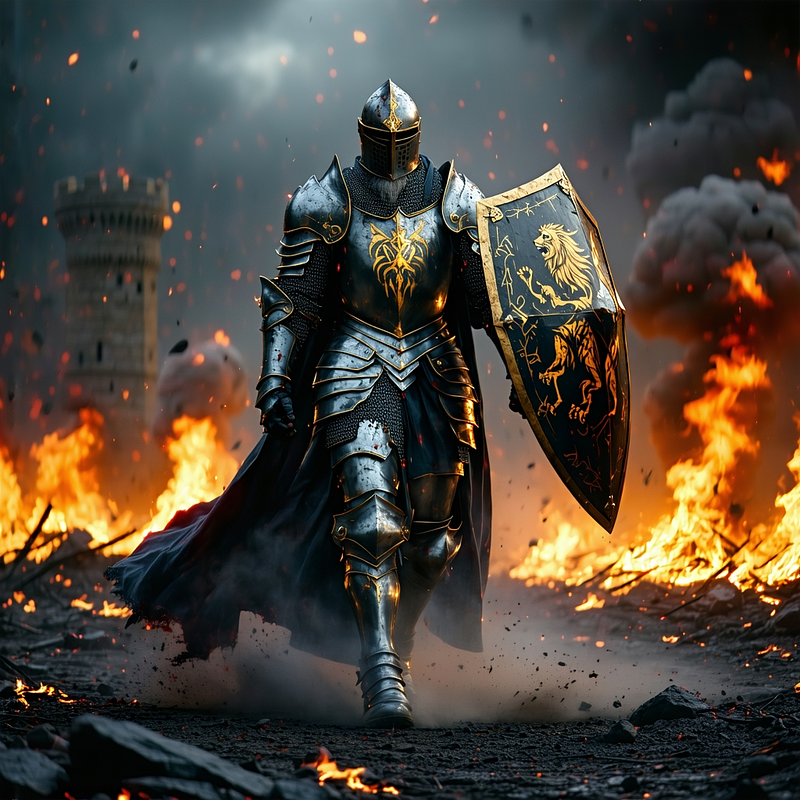


7 months ago
(Primary Subject: Gigantic Bone-Crafted Spider-God in Subterranean Temple, 1.7 weight) — far below the known world, past layers of ash-fossil and silence, lies the Cathedral of Hollow Depths—a vast, bone-built cavern where a titanic arachnid creature, assembled entirely from the skeletal remains of extinct giants, sleeps in stillness. This is the Bone Spider: part deity, part weapon, part grief embodied. Its body spans a cathedral in width—eight skeletal legs twist like ribcages fused into spires, with joints of fossilized ivory and sinew-bound marrow. Its thorax is a tomb of whispering skulls, and from its open ribbed abdomen hangs a vast, silken tapestry woven from spinal cords and ghost threads. Ancient monastic figures have spent lifetimes adding to the tapestry, recording a single question: why does it still wait? A lone knight now descends the spiral bone stairway, their lantern casting flickering light through columns of femurs and vaulted ceilings made of petrified jawbones. Clutched in their gauntlet: a relic carved from the tooth of the first world-eater. This knight is not here to slay. They are here to ask the spider something. Something no one dares speak aloud. The atmosphere is hushed and holy. From the spider’s unmoving fangs drips liquid memory, collecting in stone basins etched with prayers. The air hums faintly, filled with psalms sung by deep-buried bone choirs. The architecture is Giger-esque fused with ancient cathedral design—organic, sacred, horrifyingly beautiful. Soft beams of bioluminescent green and faded amber pour from fractures in the cavern ceiling, creating volumetric shafts of sacred decay. The knight’s figure is dwarfed beneath the weight of silence and shadow, the Bone Spider looming like a sleeping god, its massive eye sockets hollow but aware. Rendered in dark cinematic realism, with richly detailed textures: bone porosity, decayed velvet, wet stone, silk-strand threads catching subtle glints of cold light. Subtle film grain, shallow depth-of-field, and burned edge vignetting evoke the look of forbidden 70s horror photography (sacred horror + visual dread, 1.4 weight).

7 months ago
Ultra high 4K digital painting of a ruthless, battle-hardened Paladin in dark, tarnished silver armor, his full-faced plate helmet concealing all emotion except for a long, flowing golden ponytail. A tattered yet commanding white and blood-red cape billows behind him as he strides forward across a scorched battlefield. His sword gleams menacingly under an overcast sky, dripping with the blood of the fallen, while his massive shield bears a lion emblem, now cracked and battle-worn. Towering behind him, the colossal Alexander looms like a divine citadel fused with a war machine—its intricate stone body adorned with glowing golden runes, pulsating with sacred yet merciless energy. Its massive, rune-carved arms extend outward, exuding an aura of divine judgment and destruction. The battlefield is littered with broken weapons and fallen warriors, dust and embers swirling in the air. The scene has a final boss aesthetic, blending Unreal Engine 5 rendering, ZBrush sculpting, and Substance Painter detailing for ultra-realistic textures. Cinematic lighting, photorealistic depth, 8K resolution, masterpiece composition, wide-angle shot, Kinfolk photography style

3 days ago
Album Cover for: “Trône sur les Ruines” Format: Wide shot, full body, cinematic environment, poster-quality Ultra-realistic cinematic concept art of a Moroccan man in his late 20s — light brown skin, clean-shaven, with a short buzz cut and medium taper fade — sitting proudly and powerfully on a massive brutalist throne. His body language is heavy and dominant: legs planted wide, elbows on knees, hands gripping the throne armrests. His eyes lock directly onto the viewer — serious, furious, proud. His expression carries the weight of survival and leadership born through chaos. He looks like a street king forged in war, not luxury. The throne is enormous, crafted from cracked concrete, twisted rebar, scorched books, shattered electronics, rusted weapons, and destroyed satellite parts — a symbolic fusion of revolution and ruin. It sits atop rubble and ash. Behind him, the destroyed skyline of a Moroccan city: burned buildings, collapsed domes, broken antennas, crumbling high-rises, graffiti-scarred walls. A torn Moroccan flag flutters in the distance, hanging from a bent metal pole. The man wears a modern warrior-royalty outfit: a long dark trench coat made from military fabric, lined with faded golden Moroccan embroidery (zellige patterns), a worn bulletproof vest underneath, armored combat pants with tactical straps, and black scratched leather boots. A tattered deep red cloak is thrown over one shoulder. On his chest, a bent metal star medal — not shiny, but earned. His crown is raw and symbolic: cracked gold fused with rusted iron, dented like it survived fire — resting slightly tilted on his head. The sky is cinematic: thick storm clouds rolling in, deep greys and purples, with one sharp beam of golden-orange light breaking through — hope after destruction. Ash and dust drift in the air, adding texture and motion. Typography: “Trône sur les Ruines” in cracked gold serif font, minimalist, sharp, placed bottom right or top left. Color palette: Ash grey, Moroccan red, coal black, bronze gold, burnt orange, storm blue. Mood: Powerful, apocalyptic, victorious. A portrait of survival and reclaimed legacy. Style: Cinematic, ultra-detailed, wide angle, poster-quality realism. Inspired by Yeezus, French war photojournalism, LiveLoveA$AP, and dystopian street rebellion aesthetics. — full body shot, wide angle, cinematic composition, Moroccan ruins in full view, background visible, throne fully visible, urban destruction, ash particles, crown visible, golden light from clouds, no blur, no fantasy, hyper-detailed, realistic lighting, gritty textures
